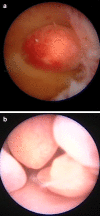Endometrial Polyps and Subfertility
- PMID: 28242961
- PMCID: PMC5306103
- DOI: 10.1007/s13224-016-0929-4
Endometrial Polyps and Subfertility
Abstract
Endometrial polyps are frequently seen in subfertile women, and there is some evidence suggesting a detrimental effect on fertility. How polyps contribute to subfertility and pregnancy loss is uncertain and possible mechanisms are poorly understood. It may be related to mechanical interference with sperm transport, embryo implantation or through intrauterine inflammation or altered production of endometrial receptivity factors. Different diagnostic modalities such as two- or three-dimensional transvaginal ultrasound, saline infusion sonography or hysteroscopy are commonly used to evaluate endometrial polyps with good detection rates. The approach of clinicians towards polyps detected during infertility investigations is not clearly known, and it is quite likely that there is wide variation amongst different groups. Most clinicians suggest hysteroscopy and polyp removal if a polyp is suspected before stimulation for in vitro fertilisation or a frozen embryo transfer cycle. However, the clinical evidence and benefit of different management options during assisted reproduction technology cycles are conflicting. Currently, there is insufficient evidence to recommend one particular option over others when a polyp is suspected during stimulation for in vitro fertilisation. A properly designed randomized controlled trial is needed to determine the best treatment option. In this article, we present the available evidence and our practice related to different diagnostic modalities and management options. We also discuss the available literature relevant to the management of endometrial polyps in relation to natural conception, intrauterine insemination and in vitro fertilisation.
Keywords: Endometrial polyps; Hysteroscopy; In vitro fertilisation; Infertility; Ultrasound.
Conflict of interest statement
Conflict of interest
Ertan Saridogan and Ali Al Chami have no conflict of interest.
Statement of human and animal rights
This article does not contain any studies with human or animal subjects performed by any of the authors.
Informed consent
For this type of study, formal consent is not required.
Figures
References
-
- Clevenger-Hoeft M, Syrop CH, Stovall DW, et al. Sonohysterography in premenopausal women with and without abnormal bleeding. Obstet Gynecol. 1999;94:516–520. - PubMed
Publication types
LinkOut - more resources
Full Text Sources
Other Literature Sources



